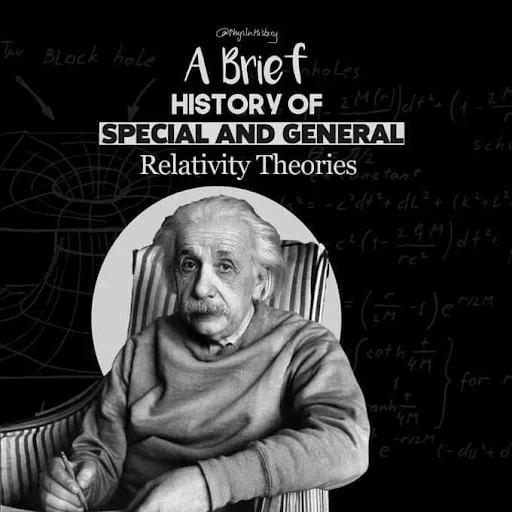A brief history of Einstein's relativity: The special and general theory
1887: The Michelson–Morley experiment fails to detect any motion of the Earth through the luminiferous aether, a hypothetical medium for the propagation of light.
1892–1904: Hendrik Lorentz develops the Lorentz transformations, a set of equations that relate the coordinates and time of two inertial frames moving at a constant velocity relative to each other. He also introduces the concepts of length contraction and local time to explain the null result of the Michelson–Morley experiment.
1900: Max Planck proposes the quantum hypothesis, that light consists of discrete packets of energy called quanta, to explain the black-body radiation phenomenon.
1905: Albert Einstein publishes his paper on special relativity, in which he derives the Lorentz transformations from two postulates: the principle of relativity and the constancy of the speed of light. He also shows that mass and energy are equivalent, according to his famous equation E = mc².
1907: Einstein introduces the equivalence principle, which states that the effects of gravity are indistinguishable from those of acceleration.
1908: Hermann Minkowski presents his four-dimensional spacetime formulation of special relativity, which unifies space and time into a single entity.
1911: Einstein predicts the gravitational redshift, that light loses energy as it escapes from a gravitational field, thus shifting to lower frequencies.
1915: Einstein completes his general theory of relativity, a theory of gravity that describes gravity as a consequence of the curvature of spacetime caused by mass and energy. He also applies his theory to explain the anomalous precession of Mercury's orbit.
1916: Einstein predicts the existence of gravitational waves, ripples in spacetime that propagate at the speed of light and are produced by accelerating masses.
1919: Arthur Eddington confirms Einstein's prediction of the gravitational deflection of light by observing the bending of starlight during a solar eclipse.
1926: Einstein writes an essay on space-time for Britannica, explaining his theories in simple terms.
1960s–1970s: The golden age of general relativity, when many new solutions to Einstein's field equations are discovered, such as black holes, wormholes, and cosmological models.
1974: The discovery of the Hulse–Taylor binary system, a pair of neutron stars orbiting each other and emitting gravitational waves. This provides the first indirect evidence for gravitational waves.
2015: The first direct detection of gravitational waves by the LIGO and Virgo collaborations, from the merger of two black holes. This confirms one of the major predictions of general relativity.
2019: The first image of a black hole's shadow by the Event Horizon Telescope, showing the effects of extreme gravity on light around a supermassive black hole at the center of a galaxy. This provides another test for general relativity.
Sejarah singkat relativitas Einstein: Teori khusus dan umum
1887: Eksperimen Michelson-Morley gagal mendeteksi gerakan Bumi melalui aether bercahaya, media hipotetis untuk propagasi cahaya.
1893-1904: Hendrik Lorentz mengembangkan transformasi Lorentz, seperangkat persamaan yang menghubungkan koordinat dan waktu dari dua bingkai inersia bergerak pada kecepatan konstan relatif satu sama lain. Dia juga memperkenalkan konsep kontrak panjang dan waktu setempat untuk menjelaskan hasil nol dari eksperimen Michelson-Morley.
1900: Max Planck mengusulkan hipotesa quantum, bahwa cahaya terdiri dari paket energi diskrit yang disebut quanta, untuk menjelaskan fenomena radiasi benda hitam.
1905, Albert Einstein menerbitkan makalahnya tentang relativitas khusus, di mana ia memperoleh transformasi Lorentz dari dua postulat: prinsip relativitas dan kekuatan kecepatan cahaya. Dia juga menunjukkan bahwa massa dan energi setara, menurut persamaan terkenal E = mc2.
1907, Einstein memperkenalkan prinsip kesetaraan, yang menyatakan bahwa efek gravitasi tidak dapat dibedakan dari akselerasi.
1908: Hermann Minkowski mempersembahkan rumusan ruang-waktu empat dimensi relativitas khusus, yang menyatukan ruang dan waktu menjadi satu kesatuan.
1911: Einstein memprediksi pergeseran merah gravitasi, bahwa cahaya kehilangan energi karena lolos dari medan gravitasi, sehingga bergeser ke frekuensi yang lebih rendah.
1915: Einstein melengkapi teori relativitas umum, sebuah teori gravitasi yang menggambarkan gravitasi sebagai konsekuensi dari kelengkungan ruang-waktu yang disebabkan oleh massa dan energi. Dia juga menerapkan teori untuk menjelaskan presesi anomali orbit Mercury.
1916, Einstein memprediksi keberadaan gelombang gravitasi, riak dalam ruang-waktu yang merambat pada kecepatan cahaya dan diproduksi oleh massa yang akselerasi.
1919: Arthur Eddington mengonfirmasikan prediksi Einstein tentang defleksi gravitasi cahaya dengan mengamati pembengkokan cahaya bintang selama gerhana matahari.
1926: Einstein menulis sebuah esay tentang ruang-waktu untuk Britannica, menjelaskan teori-teorinya dalam istilah sederhana.
1960an-1970an: Zaman keemasan relativitas umum, ketika banyak solusi baru untuk persamaan medan Einstein ditemukan, seperti lubang hitam, lubang cacing, dan model-model kosmik.
1974: Penemuan sistem Biner Hulse-Taylor, sepasang bintang-bintang Neutron yang saling mengelilingi dan memancarkan gelombang gravitasi. Ini memberikan bukti tidak langsung pertama untuk gelombang gravitasi.
2015: Deteksi langsung pertama gelombang gravitasi oleh kolaborasi LIGO dan Virgo, dari gabungan dua lubang hitam. Ini menegaskan salah satu prediksi utama relativitas umum.
2019: Gambar pertama bayangan lubang hitam oleh Event Horizon Telescope, menunjukkan efek gravitasi ekstrem pada cahaya di sekitar lubang hitam supermasif di pusat galaksi. Ini memberikan tes lain untuk relativitas umum.

